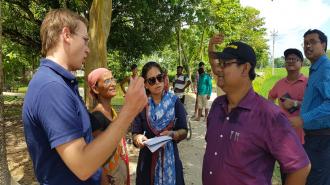SRFSI Progress: Thoughts from the field
Brendan Brown and Sofina Maharjan
August 31, 2018
From the 12th to the 20th of August, CIMMYT staff Dr TP Tiwari, Dr Brendan Brown and Ms Sofina Maharjan were in the field to liaise with partners on the progress being made on CASI trials and promotional activities. The trip involved meeting with government officials, universities, and many of the farmer and service provider organisations currently implementing scaling activities, or looking to invest in, CASI practices. The group were encouraged to see ambitious plans being developed and implemented to take CASI to the next stages beyond the life of the project, and particularly the collaborative approach being taken by partners. This has set the foundations for the next phase of the SFFSI project as we move towards sustaining impact beyond the life of the project.
One of the highlights of the trip for new CIMMYT researcher Dr Brendan Brown was meeting with a group of more than 40 Service providers in West Bengal to discuss their vision for the next 5 years in achieving their business goals related to CASI service provision. Brendan reflects that “at least half of the room were stating that they had either invested in CASI machinery in preparation for the coming season, or had the strong intention to. This is a sign that momentum is growing for CASI, and that conditions are such that private investment is occurring. It means the message is starting to spread that CA service provision is a viable commercial venture, which will only help in the scaling of CASI and uptake by farmers”.
The SRSFI project is now working to move its research from ‘proof of concept’ to ‘scaling’ to ensure the longevity of impact. This means working with new partners and investors such as these emerging CASI service providers to understand their vision, what they need to do to reach that vision, and what further brokering and information the project can provide to ensure their success.
The group also undertook visits in Bihar state of India and the eastern Terai of Nepal. In Bihar, the group met with colleagues from Bihar Agricultural University (including the Vice- Chancellor), JEEViKA, and Agrevolution, and used the time to visit field sites as well as discuss scaling of CASI. In Nepal, the group interacted with authorities from the Prime Minister’s Agricultural Modernisation Program (PMAMP Director) to understand synergies between our programs, as well as meeting the provincial secretary in Province 1 to better align activities with other governmental programs. Such high level brokerage is key to creating an enabling environment for CASI scaling. The project has also been a part of the policy dialogue in West Bengal recently, and will partake in similar CASI policy dialogue in Bihar in September.
The group came away with a few key take-away messages of the priorities from communities we visited:
1] Farmers and service providers are still unsure about herbicides. Farmers in particular requested further training on the methods and timings of herbicide application, as well as the flexibility within CASI systems to adapt to wet seasons where timing of herbicide applications between rain events is difficult;
2] There is a need for ‘360o’ training – from inputs to crop management, to post harvest processing and particularly for service providers. This is reflected in the capacity development program being implemented through the SRFSI scaling variation. We heard many times that demand was high for CASI practices and machines were available, but the knowhow of service providers was still lacking;
3] Information and training is still sparse in the community despite growing demand for CASI, and the best efforts of the project partners to provide training. The informational exchange mechanisms are still a work in progress, and require further work to ensure equitable access and livelihood development. In particular, farmers requested ‘seeing is believing’ exchange visits to grow their understanding; and
4] Research questions remain on business models that will lead to success, and particularly for locally relevant recommendations across the various regions that SRSFI works in. One promising model discussed in West Bengal was that of a ’50 day model’ where the service provider is responsible for the crop in during planting and establishment. Farmers are interested in sharing the risk with new technologies, and hence why this is seen as a potentially beneficial business model.
All in all, the groundwork for the coming rabi season is set, with ambitious targets and a growing interest from those who would consider investing, both at the farm and by service providers. The challenge as we move to scaling is understanding what further research and information is needed, and quickly addressing these to ensure success.
Copyright 2019. All rights reserved

